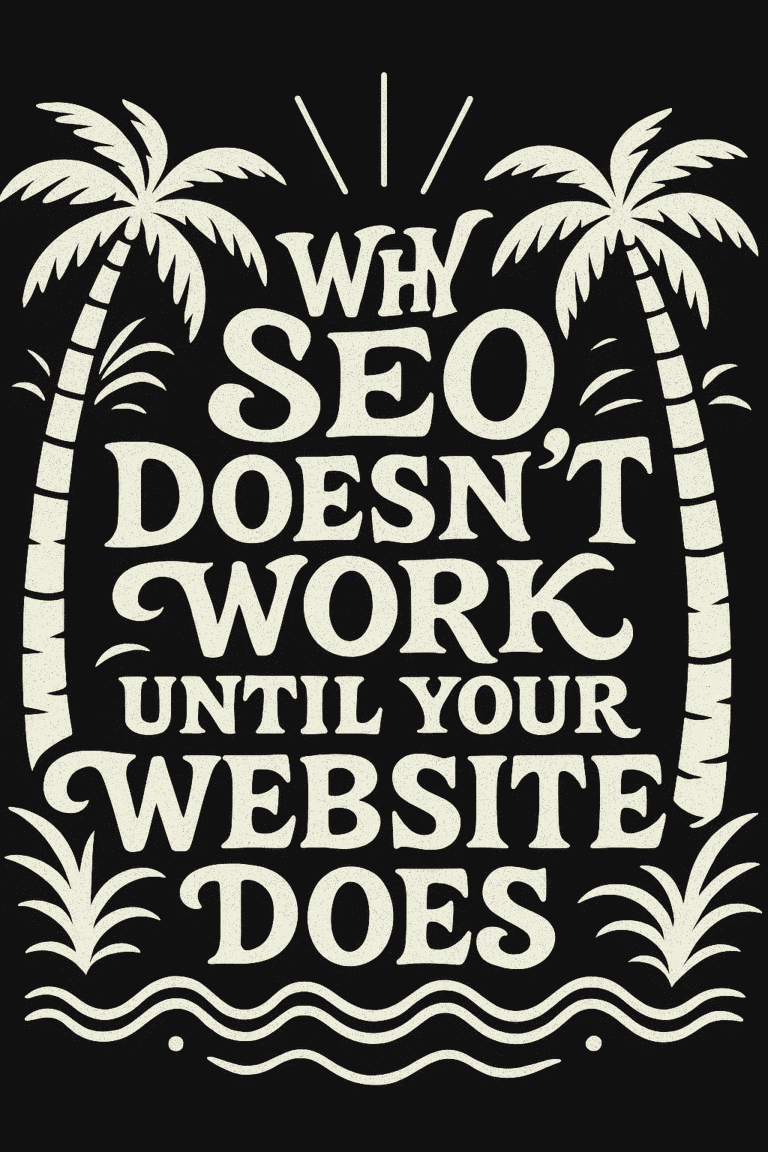
A business’s website is more than just a virtual calling card; it’s the heart of its online presence, a customer service representative, a sales associate, and often, the first point of contact with potential clients. The importance of a website today cannot be overstated — it’s where first impressions are formed and can be the deciding factor between a lead and a lost opportunity.
But just having a website isn’t enough. With the New Year coming up quickly, it’s time to talk about resolutions — not just the personal kind, but those pivotal decisions that can steer your business towards success. This year, consider a website audit as a cornerstone of your strategic plan. A comprehensive website audit is akin to a health check-up for your online presence, assessing everything from design and content to functionality and performance.
Why should this be on your list of resolutions, you ask? Because a website audit can illuminate hidden issues, unlock performance potential, and ensure your website aligns with your business goals. It’s not just about fixing what’s broken; it’s about optimizing for what could be.
In the coming sections, we’ll dive into the transformative power of a website audit and explore how making this part of your New Year’s resolution can set your business up for a year of growth, engagement, and success.
The Role of Your Website in Modern Business
Imagine walking down a bustling street lined with shops. The storefronts, with their vibrant displays and welcoming entrances, are not just physical spaces; they’re carefully curated experiences designed to draw you in. Online, your website is the virtual equivalent of this storefront. It’s the digital facade that greets your potential customers, and just like in the physical world, first impressions matter immensely.
A website is often the first interaction a customer has with your brand. It’s where they get their initial taste of your company’s personality, values, and offerings. A well-designed website communicates professionalism, credibility, and trustworthiness, while a poorly constructed one can send potential customers running to competitors.
But the role of a website goes beyond just making a good first impression. It’s a multitasking powerhouse. It serves as a marketing tool, a communication platform, a sales channel, and often, a customer service portal. It works around the clock, reaching out to potential clients across time zones and geographies, something no physical storefront could ever do.
User experience (UX) is another critical aspect of your website’s role. In a world where attention spans are short and alternatives are just a click away, the user experience can make or break a business. A website with intuitive navigation, fast loading times, and accessible information keeps users engaged and reduces bounce rates. On the other hand, a site that’s difficult to use, slow to load, or hard to navigate can frustrate users, tarnishing your brand image and reducing the likelihood of conversion.
In essence, your website is not just part of your business — in many ways, it is your business. It’s a reflection of your brand’s identity and an embodiment of your customer service ethos. That’s why it’s crucial to ensure that this digital ambassador represents you effectively, engages visitors positively, and converts interest into action.
What is a Website Audit?
In the simplest terms, a website audit is a full analysis of all the factors that affect a website’s visibility, usability, and effectiveness. Think of it as a comprehensive check-up for your online presence, diagnosing issues, identifying opportunities, and prescribing solutions. It’s about taking a step back, scrutinizing every element through a critical lens, and asking, “Is this the best it can be?”
A website audit covers several key components:
- Design: This encompasses the visual elements of your site, including layout, color schemes, typography, and imagery. A design audit ensures that your website not only looks appealing but also aligns with your brand identity and resonates with your target audience.
- Content: Content is king, and a content audit evaluates the relevance, clarity, and value of the information presented on your site. It also checks for consistency in messaging, tone of voice, and brand narrative.
- SEO (Search Engine Optimization): SEO is vital for online visibility. An SEO audit looks at keywords, meta tags, linking structures, and other elements to ensure that your site is easily discoverable and ranks well on search engine results pages (SERPs).
- Functionality: This component checks for user-friendliness. Are there broken links? Do all forms work as intended? Is the site navigation intuitive? A functionality audit ensures that your site is as user-friendly and accessible as possible.
- Performance: Site speed and loading times are crucial for retaining visitors. Performance audits analyze these aspects, along with mobile responsiveness, to guarantee a smooth experience for all users, regardless of device.
- Security: With cyber threats on the rise, a security audit examines vulnerabilities, assesses data protection measures, and ensures that your site and your visitors’ information are safe from potential breaches.
Together, these components form the backbone of a website audit, providing a clear picture of your website’s current state and paving the way for informed enhancements. It’s a holistic approach that leaves no stone unturned in the quest for online excellence.
Reasons to Conduct a Website Audit
A website audit isn’t just about fixing what’s broken; it’s a proactive measure to ensure your online presence remains robust, relevant, and reflective of your brand’s evolution. Here are some compelling reasons why a website audit should be an integral part of your digital strategy:
Outdated Design: Design trends evolve rapidly, and what was cutting-edge a few years ago might now be passé. An audit can identify design elements that need refreshing. Staying current with design trends shows your audience that you’re a forward-thinking brand, attentive to the user experience and committed to maintaining a modern, approachable online presence.
Content Relevance: The digital world is dynamic, and your content should reflect that. An audit can reveal outdated information, missed content opportunities, or areas where your message isn’t as clear as it could be. Keeping content fresh and relevant not only provides value to your audience but also reinforces your position as an authority in your field.
SEO Best Practices: Search engines continually update their algorithms, and an SEO strategy that worked yesterday might not be as effective today. Regular audits ensure your website complies with the latest best practices, helping you maintain or improve your search rankings and remain visible to your target audience.
Functionality and User Experience: A glitchy, hard-to-navigate website can be a major turn-off for visitors. An audit evaluates the user journey, identifying any barriers that might prevent a smooth and enjoyable experience. The goal is to make every interaction with your website intuitive and satisfying.
Performance Optimization: In an age of instant gratification, slow load times can be a death knell for your site’s retention rates. Performance audits highlight areas where speed and efficiency can be boosted, ensuring your site loads quickly and runs smoothly, keeping visitors engaged.
Security Concerns: Cybersecurity threats are a constant concern. A security audit can uncover vulnerabilities in your website, allowing you to address them before they’re exploited. Protecting your visitors’ data isn’t just about compliance; it’s about building and maintaining trust.
Each of these reasons underscores the importance of regular website audits. By identifying areas for improvement and staying ahead of industry shifts, you’re not just maintaining your website; you’re refining an asset that’s crucial to your business’s success.
How to Get Started on Your Website Audit
Embarking on a website audit can seem daunting, but with a structured approach and the right tools, it can be a transformative process. Here’s a step-by-step guide to help you get started:
1. Set Clear Objectives: Begin by defining what you want to achieve with your audit. Are you looking to improve load times, enhance user experience, or boost your SEO rankings? Having clear goals will focus your efforts and make the outcomes more measurable.
2. Gather Your Tools: Several online tools can aid in your website audit. For SEO, platforms like Google Analytics and SEMrush provide invaluable insights into your site’s search performance. Tools like GTmetrix or Google PageSpeed Insights can help assess your site’s loading speed, while services like Sucuri can scan for security vulnerabilities.
3. Evaluate Your Design: Take a critical look at your website’s design. Does it align with your brand identity? Is it appealing to your target audience? Does it follow modern design practices? Sometimes, getting an external perspective can be beneficial, so consider soliciting feedback from clients or colleagues.
4. Assess Your Content: Review your content for relevance, clarity, and engagement. Is it up-to-date? Does it reflect your brand voice? Tools like Screaming Frog can crawl your site to help you inventory your content and spot areas that need updating.
5. Analyze SEO and Functionality: Use your SEO tools to examine keyword optimization, meta tags, and link structures. Check for broken links, ensure all forms and functionalities work, and confirm that your site navigation is intuitive.
6. Test Performance and Security: Utilize speed testing tools to analyze load times and identify bottlenecks. Conduct security checks to ensure your site is protected against threats and that user data is secure.
7. Create an Action Plan: Based on your findings, develop a prioritized list of actions. Some issues may be quick fixes, while others might require more extensive work. Tackle the most critical issues first, especially those affecting user experience and security.
8. Implement, Test, and Monitor: Begin making the necessary changes based on your action plan. After each change, test your site to ensure it’s functioning as expected. Continue to monitor your site’s performance over time, making adjustments as needed.
Remember, a website audit is not a one-time task. It’s an ongoing process of refinement and improvement. As your business grows and evolves, so should your website. Regular audits ensure your digital storefront remains an accurate reflection of your brand and continues to serve your business effectively.
Setting SMART Goals for Your Website in the New Year
As you gear up for the New Year, it’s the perfect time to set intentional, strategic goals for your website. Employing the SMART framework can provide clarity and direction for your digital ambitions. SMART goals are Specific, Measurable, Achievable, Relevant, and Time-bound. Here’s how you can apply this approach to your website’s improvement:
Specific: Vague goals are hard to achieve. Instead of aiming to “improve your website,” pinpoint exact areas you want to enhance. For instance, “Increase website conversion rates by redesigning the checkout process.”
Measurable: Attach metrics to your goals to track progress. If your goal is to enhance SEO, define what success looks like. Is it a higher ranking for certain keywords, or a specific percentage increase in organic traffic?
Achievable: While it’s great to aim high, your goals should be attainable. Evaluate your resources and capabilities to ensure the goals you’re setting are within reach. Overambitious goals can be discouraging if they’re not realistic.
Relevant: Your website goals should align with your broader business objectives. If your aim for the year is to expand your product line, ensure your website goals support this, perhaps by focusing on new product pages or related marketing campaigns.
Time-bound: Every goal needs a deadline. Without a timeframe, there’s no sense of urgency or a clear endpoint. Set deadlines for your goals to keep yourself accountable and track progress over time.
By setting SMART goals for your website, you create a clear roadmap for the improvements you wish to see. Whether it’s boosting user engagement, increasing sales, or improving your SEO rankings, SMART goals provide the structure and motivation needed to turn those digital resolutions into reality.
Maintaining Your Website Post-Audit
A website audit can provide a wealth of insights, but its true value lies in the ongoing actions taken afterward. To ensure your website continues to serve as a dynamic, effective tool for your business, consider these maintenance tips:
1. Schedule Regular Check-Ups: Just like a car, your website needs regular maintenance to function at its best. Set a schedule for periodic reviews—monthly, quarterly, or biannually—to check on the health of your website and make necessary updates.
2. Stay Informed on Trends: Everything is always evolving. Keep an eye on the latest trends in web design, SEO, and technology to ensure your site remains current and competitive.
3. Monitor User Feedback: Your users are a valuable source of information. Pay attention to their feedback, reviews, and behavior on your site. Tools like heat maps or user surveys can provide insights into how visitors interact with your website and what improvements they desire.
4. Update Content Regularly: Keep your content fresh and relevant. Regularly update blog posts, news sections, and product pages. Not only does this provide value to your visitors, but it also signals to search engines that your site is active and relevant, which can help with SEO.
5. Track Performance Metrics: Use analytics tools to continuously monitor your website’s performance. Keep an eye on metrics like traffic, bounce rate, conversion rate, and page load times. This data can help you identify areas for improvement and gauge the success of the changes you implement.
6. Stay Proactive with Security: Cyber threats are ever-present and ever-evolving. Stay proactive by regularly updating your site’s security measures, running scans, and ensuring all software and plugins are up to date.
By making website maintenance an ongoing priority, you’ll not only preserve the improvements made during your audit but also foster continuous growth and enhancement. A well-maintained website not only reflects well on your brand but also provides a solid foundation for achieving your business goals in the New Year and beyond.
Your Website’s New Year Revitalization Plan
As we’ve explored, your website is the online heartbeat of your business, making a comprehensive website audit an invaluable resolution for the New Year. By understanding the critical role your website plays in modern business, the multifaceted nature of website audits, and the importance of setting SMART goals, you’re well on your way to enhancing your online presence.
But the journey doesn’t end post-audit. Maintaining your website’s health is an ongoing process, one that requires regular attention and proactive measures. By staying vigilant and responsive you can ensure your website continues to grow alongside your business.
Ready to make a website audit part of your New Year’s resolution? Contact us at Graticle Design. Our team is equipped to provide you with a thorough assessment and actionable insights to elevate your website in the coming year. Let’s make 2024 the year your website truly shines!





